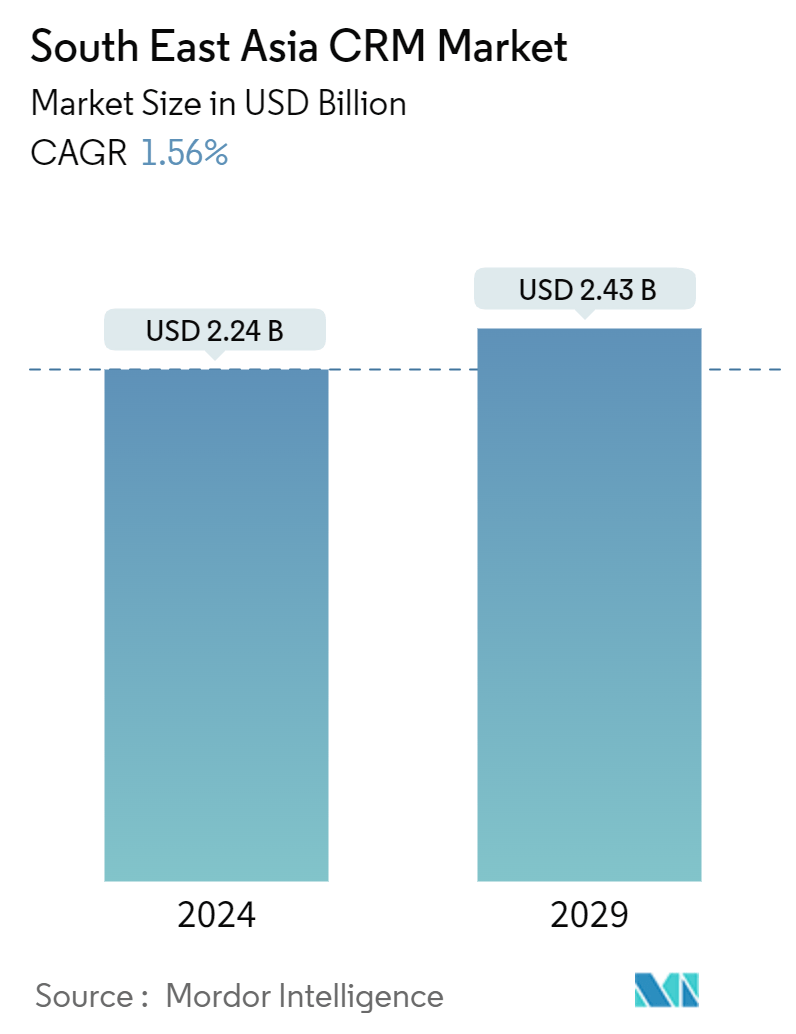Market Size of South East Asia CRM Industry

| Study Period | 2019 - 2029 |
| Base Year For Estimation | 2023 |
| Market Size (2024) | USD 2.24 Billion |
| Market Size (2029) | USD 2.43 Billion |
| CAGR (2024 - 2029) | 1.56 % |
| Market Concentration | Medium |
Major Players
*Disclaimer: Major Players sorted in no particular order |
South East Asia CRM Market Analysis
The South East Asia CRM Market size is estimated at USD 2.24 billion in 2024, and is expected to reach USD 2.43 billion by 2029, growing at a CAGR of 1.56% during the forecast period (2024-2029).
Mature customer service, automated engagement, improved customer experience, and increasing scope of digital operations are a few factors fueling the demand for CRM solutions across various industry verticals in the region.
- Moreover, the development of cloud computing technology and the availability of various service models, such as SaaS, Platform as a Service (PaaS), and Infrastructure as a Service (IaaS), are also expected to drive market growth during the forecast period in the region.
- Southeast Asia has witnessed an uptake in midmarket and enterprise companies moving to more modern business software applications to enhance their business processes and enrich the customer experience. E-commerce, ERP, and Customer Relationship Management (CRM) applications have all been at the forefront of this software technology adoption.
- Furthermore, the increasing emphasis on customer engagement among enterprises and growing adoption from SMEs aided by flexible pricing strategies provided by the vendors are driving market growth in the region.
- According to the CRM Cloud Survey Report by SoftClouds (a vendor in technology solutions and digital transformation), 82% of companies use CRM solutions for sales process automation and sales reporting. According to Salesforce, CRM software helps to increase employee productivity, enhance customer engagement and retention, and reap other business benefits. According to Cloudswave, using CRM in sales can increase the number of purchases customers make with the company. These facts are likely to boost the market growth in the region.
South East Asia CRM Industry Segmentation
The Customer Relationship Management (CRM) Software market is a subsegment of the Enterprise Software market geared toward managing external business contacts and communication in marketing, sales, and acquisition. It offers standalone software designed to help end-user companies manage a customer's entire life cycle, including marketing, sales, customer services, and contact center. The market estimations consider CRM software applications (license/subscription) in Sales, Marketing, Contact centers, and Customer Services. In contrast, CRM Analytics and other custom applications of CRM Software are excluded from the study scope as these are offered as an enhanced capability based on requirement and charged for customization that is not tracked owing to feasibility factors.
The Southeast Asian CRM market is segmented by organization size (small and medium and large scale), deployment size (cloud, on-premise, and hybrid), end-user vertical (services, manufacturing, BFSI, retail and logistics, government), and country (Indonesia, Singapore, Philippines, Thailand, Malaysia, Rest of South East Asia)
The market sizes and forecasts are provided in terms of value (in USD) for all the above segments.
| By Organization Size | |
| Small and Medium | |
| Large Scale |
| By Deployment Size | |
| Cloud | |
| On-premise | |
| Hybrid |
| By End-user Vertical | |
| Services | |
| Manufacturing | |
| BFSI | |
| Retail and Logistics | |
| Government | |
| Other End-user Verticals (Construction, Not for Profits, Education, Energy & Utilities, etc.) |
| By Country | |
| Indonesia | |
| Singapore | |
| Philippines | |
| Thailand | |
| Malaysia | |
| Rest of South East Asia |
South East Asia CRM Market Size Summary
The South East Asia CRM market is poised for steady growth, driven by the increasing demand for advanced customer relationship management solutions across various industry sectors. Factors such as mature customer service, automated engagement, and enhanced customer experiences are key contributors to this demand. The region's adoption of cloud computing technologies, including SaaS, PaaS, and IaaS models, is further propelling market expansion. The shift towards modern business software applications by midmarket and enterprise companies, particularly in e-commerce, ERP, and CRM, underscores the region's commitment to improving business processes and customer engagement. The growing emphasis on customer engagement, coupled with flexible pricing strategies for SMEs, is also a significant driver of market growth.
The integration of IT tools like Big Data with CRM systems is expected to transform the market landscape by enabling the processing and analysis of unstructured data, thereby providing deeper customer insights. The COVID-19 pandemic has accelerated cloud adoption, with companies like NewGens Pte Ltd leveraging cloud-native solutions to expand their customer base. The rise of omnichannel retailing and real-time marketing strategies has further enhanced customer engagement capabilities. Partnerships, such as that between Bata and Capillary Technologies, highlight the effectiveness of unified campaigns and targeted marketing. The competitive landscape features both global and local players, with companies like Oracle, Salesforce, and Microsoft leading innovations in CRM solutions. These developments, along with strategic acquisitions and product enhancements, are set to strengthen market positions and drive profitability in the region.
South East Asia CRM Market Size - Table of Contents
-
1. MARKET DYNAMICS
-
1.1 Market Overview
-
1.2 Industry Attractiveness - Porter's Five Forces Analysis
-
1.2.1 Bargaining Power of Suppliers
-
1.2.2 Bargaining Power of Buyers
-
1.2.3 Threat of New Entrants
-
1.2.4 Threat of Substitute Products
-
1.2.5 Intensity of Competitive Rivalry
-
-
1.3 Market Drivers
-
1.3.1 Global Cues, such as BYOD, and Use of IT tools for Driving Decision Making Expected to Provide Ample Scope for Future Growth
-
1.3.2 Emergence of Several Pure-Play CRM Solutions at a Local and Regional-Level, to Compete with the Top 5 incumbents
-
1.3.3 Increasing Adoption from SME's Aided by Flexible Pricing Strategies Provided by the Vendors
-
-
1.4 Market Challenges
-
1.4.1 Operational and Implementational Challenges
-
1.4.2 Cost and Lack of Resources and Skilled Professionals
-
-
1.5 Analysis of the Global CRM Landscape
-
1.6 Assessment of Impact of Covid-19 on the South East Asia CRM Market (Customers & Prospective buyers opting for digital channels| Growing need for SME's to utilize digital tools to engage with their target audience| Short & Medium-term trend analysis)
-
1.7 Key Segments in the CRM Industry - Contact Center, Customer Service, Sales Automation, and Marketing Automation
-
1.8 Key Considerations Involved in the Selection of a CRM tool in the SEA region
-
-
2. MARKET SEGMENTATION
-
2.1 By Organization Size
-
2.1.1 Small and Medium
-
2.1.2 Large Scale
-
-
2.2 By Deployment Size
-
2.2.1 Cloud
-
2.2.2 On-premise
-
2.2.3 Hybrid
-
-
2.3 By End-user Vertical
-
2.3.1 Services
-
2.3.2 Manufacturing
-
2.3.3 BFSI
-
2.3.4 Retail and Logistics
-
2.3.5 Government
-
2.3.6 Other End-user Verticals (Construction, Not for Profits, Education, Energy & Utilities, etc.)
-
-
2.4 By Country
-
2.4.1 Indonesia
-
2.4.2 Singapore
-
2.4.3 Philippines
-
2.4.4 Thailand
-
2.4.5 Malaysia
-
2.4.6 Rest of South East Asia
-
-
South East Asia CRM Market Size FAQs
How big is the South East Asia CRM Market?
The South East Asia CRM Market size is expected to reach USD 2.24 billion in 2024 and grow at a CAGR of 1.56% to reach USD 2.43 billion by 2029.
What is the current South East Asia CRM Market size?
In 2024, the South East Asia CRM Market size is expected to reach USD 2.24 billion.

